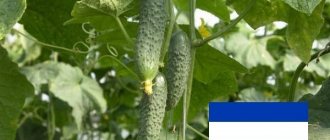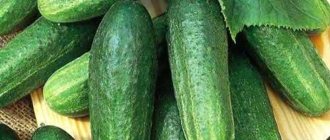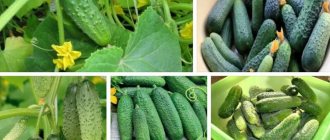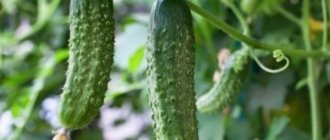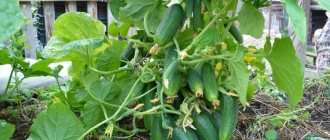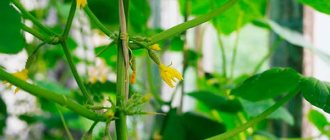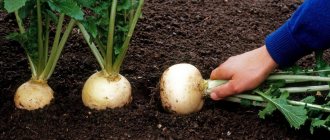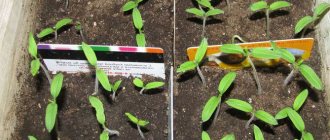Vegetable growing » Cucumbers
0
3055
Article rating
Kira Stoletova
It is better to plant cucumbers in open ground in May, when the soil has already warmed up sufficiently. By following the cultivation technology and following the rules of care, you can significantly increase the fruiting period of cucumbers, so all gardeners need to know what kind of feeding should be done for cucumbers in open ground.
Feeding cucumbers in open ground
Features of growing cucumbers in open ground
Cucumber is a very heat-loving plant, so it is recommended to plant seeds or seedlings in open ground when the soil warms up by 15 - 16 degrees . In unstable regions where there are frosts in the spring, it is better to wait for warmer weather, otherwise all the seedlings may die.
Don't forget that this is a tropical vegetable - it loves warmth and humidity. In case of early planting, you need to be prepared to cover the seedlings with film until the air warms up to the desired temperature.
The landing site must be changed periodically. On average, you can plant cucumbers in their old place once every 4 years . After melon crops, the soil is depleted and there may be no harvest. But after potatoes, tomatoes, peas, the crop grows well.
Also useful precursors are:
- carrot;
- onion;
- pepper;
- green manure.
In addition to regular care, during the entire growing season you need to do at least three feedings of cucumbers in open ground. The number of times depends on the type of soil on the site.
What soils do cucumbers like?
Cucumber vines like to grow on light soils:
- organic-rich black soil;
- sandy soils;
- sandy loam.
This is due to certain difficulties in care and watering. On such soils, you need to fertilize more often, but the yields are better, since the root system receives the necessary oxygen in sufficient quantities.
When to plant seedlings
The seedlings are transplanted into open ground when 3–4 leaves are formed on it. This method is more reliable because the plant is stronger and can tolerate small temperature fluctuations. The harvest ripens two weeks earlier.
Seeds should be planted after preliminary sorting. It is recommended to carry out the following activities for preparing seeds:
- keep it indoors near a radiator or stove heating for about a month;
- carry out disinfection with garlic solution or potassium permanganate;
- soak in the nutrient liquid of any complex mineral fertilizer or organic substances for 12 hours ;
- then keep warm for two days, covered with a damp cloth (it is important to ensure that they do not germinate prematurely);
- Just before sowing, put it in the cold for a day - preferably in the refrigerator.
Seeds prepared in this way will be less barren.
Features of care
The main task when growing cucumbers is to ensure proper watering. The humidity in the area should be maintained high, especially in the summer. If it is possible to organize soil moistening using a drip method (like a greenhouse), then the harvest will be excellent.
Fertilizers for cucumbers in open ground are the main condition for their fruiting, not counting watering. You need a full range of basic nutrients - nitrogen, potassium and phosphorus, as well as trace elements - calcium, sulfur, magnesium.
Video: The intricacies of growing cucumbers in open ground
To ensure fruiting does not stop, you need to harvest 2-3 times a week. In this way, the formation of new ovaries and their maturation are stimulated.
What to feed cucumbers during flowering and fruit set
Flowering and the beginning of fruiting are a very important period in the development of cucumbers. The crop's need for nutrients at this time increases sharply; if it is ignored, there will be no need to talk about the quality of the fruit. Without a sufficient amount of fertilizer, barren flowers will predominate on cucumbers, which means you can’t expect a good harvest. What is the best way to support cucumbers at this stage of development?
Complex mineral fertilizers
When entering the flowering and fruiting phase, cucumbers need three essential elements: nitrogen, phosphorus and potassium. The solution can be prepared independently using 30 g of ammonium nitrate, 40 g of superphosphate and 20 g of potassium salt per 10 liters of water. To reduce the number of barren flowers, at the very beginning of flowering, the bushes are sprayed with the preparation “Ovary”.
At this stage and during the development of the ovary, industrial complex fertilizers are also used for vegetable crops or specifically for cucumbers:
- for zucchini and cucumbers "FlorGumat" (GERA);
- “Cucumber Kristalon” (Fertika);
- “For cucumbers, zucchini, squash” (Agricola);
- “Fertilizer for cucumbers and zucchini” (Clean sheet);
- “Complex fertilizer for cucumbers, zucchini, squash, pumpkins” (Good Power);
- “Organo-mineral fertilizer CUCUMBER” (Biona);
- "Spring" (Fasco).
The same complexes are produced by Biomaster, Lyukor, Antey and other manufacturers. Use the products in strict accordance with the instructions on the packaging.
Organic fertilizers
Among the organic fertilizers used for cucumbers during the flowering period, an infusion of mullein or bird droppings is used. You need to start preparing the fertilizer in advance.
Bird droppings are dissolved in water using a ratio of 1:15 and left for 3-5 days. They do exactly the same with mullein, the proportions in this case will be as follows - 0.3-0.5 liters per 10 liters of water. Before use, the solution is filtered and applied to each bush in an amount of 1 liter. Mullein and bird droppings mainly supply nitrogen to plants.
To replenish the need for potassium and calcium, fertilizing with ash is carried out. Fill the bucket one-third full with ash powder, add hot water and let it brew in a dark place for 2 days. After the specified time, the ash infusion is filtered and used for watering at the root or spraying on the leaves. Typically, this technique significantly improves the quality of flowering.
Folk remedies
Folk recipes suggest using some food products, pharmaceuticals and even waste to feed cucumbers. From all this you can make tinctures that stimulate the flowering and fruiting of cucumbers. When the first flowers appear on the bushes, you can use the following compositions:
- Iodine and milk. This mixture is both a protection against fungal diseases and a stimulator of ovary formation. A solution is prepared from 10 liters of water, 15 drops of iodine and 1 liter of milk. You can replace milk with any fermented milk product.
- Weed infusion. Freshly cut grass and weeds are placed in a barrel, filling half the volume, and then filled to the top with water. During the fermentation process, the mixture is stirred periodically. It is better to keep this fertilizer under a lid, it has an unpleasant odor. After 4-5 days, the infusion is filtered, diluted with water in a ratio of 1:5 and used for root feeding.
- Eggshell. The shells are first washed and dried, and then crushed into powder. The better the shells are ground, the higher the effectiveness of the fertilizer. The amount of powder obtained from the shells of a dozen eggs is enough for 2 liters of liquid. The product should infuse for 5-7 days. Before use, the resulting infusion is diluted with 10 liters of water and applied at the root of the plants.
- Banana peel. The skins of 3 fresh bananas are placed in a three-liter jar and filled with water. After 3 days, the infusion is diluted with the same amount of clean water and used to water the cucumbers.
On a note! Supplements prepared according to folk recipes are good because they cannot cause an overdose of microelements. In addition, these products are accessible, cheap, and do not harm the environment and humans.
Organic fertilizers for cucumbers
Any farm can find something to fertilize cucumbers in open ground with. It could be:
- chicken manure is an organic fertilizer containing large amounts of potassium and nitrogen;
- mullein – nitrogen, potassium;
- wood ash – potassium, phosphorus, trace elements;
- green fertilizer - infusion of weeds or green manure;
- bone or fish meal - nitrogen, potassium and phosphorus in small quantities.
For complete nutrition of cucumbers, it is recommended to mix organic matter with each other. For example, manure or droppings do not contain phosphorus, so it should be added in the form of bone meal or ash to ensure the growth of the root system and the full development of plants.
Compost or fresh manure – which to use?
Compost is the best way to feed cucumbers after planting them in the ground. A mature substrate based on manure or chicken droppings does not harm the roots, since excess nitrogen has evaporated and there is no danger of burning the root system of the seedlings.
To properly prepare compost, you need to lay it in layers:
- priming;
- manure;
- kitchen waste – peeling vegetables, fruits, bread, yeast, dairy products;
- garden grass - weeds or green manure.
Ripening occurs throughout the year. The pile must allow air to pass through well so that soil bacteria can multiply and process organic matter. Sometimes a bacteria concentrate is added to increase the number of types of beneficial microflora.
The finished mixture should smell like earth, be moderately moist, and not contain pathological flora and pest larvae. Compost is a good top dressing for cucumbers in open ground for the entire growing season.
In order not to harm the plants, you need to know exactly when to feed cucumbers in the open ground with fresh manure. It is applied in the fall after harvest. The substance is very aggressive, especially dry chicken manure.
Therefore, it must lie in the ground for the whole winter so that microorganisms process it into forms accessible to plants. Excess nitrogen will evaporate and by spring the soil will be ready to accept seedlings.
Bone flour
Bone meal for cucumbers can be purchased at a gardening store. It can be added at different times of the year - spring, summer, autumn. The best period will be autumn, when the cucumbers are harvested - fertilizing and soil care will occur simultaneously. Bone meal is a long-lasting fertilizer; over the course of a year it will gradually release nutrients to plants.
Ash
There are different amounts of nutrients. Coniferous ash contains more phosphorus, while deciduous and peat ash contains more calcium.
The effect of the ash is long-lasting - it provides nutrition to plants for 3 years after application . On acidic soils, the use of ash is more justified. Feeding cucumbers with ash in open ground increases the level of alkali, neutralizing the acid.
Ash fertilizer for cucumbers improves the taste of the fruit. During the period of ovary formation, cucumbers most need calcium and potassium, and may even taste bitter because of this. It is undesirable to skip the moment of feeding, since subsequently it will be impossible to eliminate the bitterness.
What nutrients do cucumbers need?
Cucumbers are quite demanding when it comes to feeding. These vegetables already have time to form fruits in a relatively short growing season (90-120 days). Accordingly, in this short period of time, plants pump out large amounts of nutrients from the soil.
Cucumbers need the following nutrients most:
- Nitrogen.
- Phosphorus.
- Potassium.
The need for these substances directly depends on the growth phase of the plant. After planting in open ground, cucumbers require large amounts of nitrogen. At the time of vine formation and flowering, cucumbers need phosphorus and potassium. During fruiting, cucumbers will again need nitrogen.
Also, do not forget about feeding with microelements. They affect the health of the plant and the taste of the fruit. A lack of magnesium is simply unacceptable for cucumbers.
Fertilizers for cucumbers should be as balanced as possible. Every vegetable grower is recommended to know the exact amount of necessary elements. Based on one plant, you will need:
- 23 grams of nitrogen.
- 14 grams of phosphorus.
- 58 grams of potassium.
- 19 grams of calcium.
- 5 grams of magnesium.
Cucumbers differ from other plants in that they take longer to absorb nutrients.
It should be noted that during fruit formation the bush consumes the most potassium and phosphorus. A lack of these substances always leads to a significant reduction in yield.
Mineral mixtures and trace elements
Fertilizing cucumbers in open ground can be done with mineral fertilizers - both single-component and complex. Experienced gardeners independently prepare fertilizers for plants, based on the needs of the soil. For beginners, it is better to use purchased ready-made complex mixtures - the content of active ingredients in them is calculated.
Mineral fertilizers are applied if cucumbers grow poorly in open ground - what to feed them with? Of course, with instant mineral mixtures. It is better to use the foliar method - this will speed up the supply of nutrition to parts of the plants.
The choice of mineral supplements for cucumbers depends on the type of soil - heavy clay or depleted peat mixture needs more potassium supplements, which directly affect the yield.
What fertilizers are suitable for open ground?
For open ground you can use:
- superphosphate – phosphorus-calcium fertilizer;
- urea, ammonium nitrate - nitrogen fertilizers;
- sodium nitrate, which is not recommended for use in greenhouses, but is suitable for cucumbers in open ground;
- potassium salt, potassium sulfate, potassium magnesium;
- nitroammophoska – a two-component mixture of nitrogen and phosphorus;
- nitrophoska, diammophos - three-component mixtures;
- ammophos is a potassium-phosphorus mixture with magnesium.
The amount of fertilizer must be calculated based on the instructions in the instructions. It is better to underfeed the plants a little than to apply a large dose and burn the roots.
Feeding cucumbers with mineral fertilizers should be stopped 2 weeks before the start of fruit harvesting in order to reduce the amount of nitrates in vegetable crops .
Mineral mixtures include complex supplements with microelements. They are sold in small containers in liquid form. Useful:
- to strengthen plant immunity;
- in the fight against fungal diseases;
- to improve the taste of fruits.
Microelements are applied by spraying onto the foliage, which allows the plants to be revived in 2–3 days. Root watering can be carried out in conjunction with complex products.
Mineral mixtures are used throughout the growing season - planned or urgently. On sandy soils, dosages are applied fractionally, the amount of fertilizing is doubled. On heavy soils, you can limit yourself to two or three fertilizing.
Bottom line
Timely feeding of cucumbers with urea and other fertilizers will accelerate the ripening of fruits and protect garden crops from diseases and parasites. Experienced farmers alternate organic fertilizers with agrochemicals and traditional methods of caring for garden crops. If there are visible symptoms of cucumber disease, the microelements missing in the soil should be replenished.
What mineral fertilizer did you use?
You can select multiple answers or enter your own.
- Superphosphate 13%, 1163 votes
1163 votes 13%1163 votes - 13% of all votes
- Urea 9%, 798 votes
798 votes 9%
798 votes - 9% of all votes
- Nitroammophoska 8%, 690 votes
690 votes 8%
690 votes - 8% of all votes
- phytosporin*7%, 605 votes
605 votes 7%
605 votes - 7% of all votes
- Dolomite flour 6%, 538 votes
538 votes 6%
538 votes - 6% of all votes
- Potassium monophosphate 5%, 451 votes
451 votes 5%
451 votes - 5% of all votes
- Azofoska*5%, 433 votes
433 votes 5%
433 votes - 5% of all votes
- Calcium nitrate*5%, 407 votes
407 votes 5%
407 votes - 5% of all votes
- complex mineral and vitamin*4%, 374 votes
374 votes 4%
374 votes - 4% of all votes
- potassium magnesia, urea, potassium sulfate, ash*4%, 315 votes
315 votes 4%
315 votes - 4% of all votes
- saltpeter*3%, 297 votes
297 votes 3%
297 votes - 3% of all votes
- Ammophoska 3%, 281 votes
281 votes 3%
281 votes - 3% of all votes
- Diammofoska 3%, 280 votes
280 votes 3%
280 votes - 3% of all votes
- View answers*3%, 261 votes
261 votes 3%
261 votes - 3% of all votes
- manure*3%, 237 votes
237 votes 3%
237 votes - 3% of all votes
- Ammonium sulfate 3%, 235 votes
235 votes 3%
235 votes - 3% of all votes
- potassium nitrate*2%, 209 votes
209 votes 2%
209 votes - 2% of all votes
- ammonium nitrate*2%, 179 votes
179 votes 2%
179 votes - 2% of all votes
- Potassium sulfate, magnesium sulfate*2%, 157 votes
157 votes 2%
157 votes - 2% of all votes
- only manure*1%, 110 votes
110 votes 1%
110 votes - 1% of all votes
- Potassium chloride 1%, 110 votes
110 votes 1%
110 votes - 1% of all votes
- Borofoska*1%, 91 votes
91 votes 1%
91 votes - 1% of all votes
- potassium humate*1%, 90 votes
90 votes 1%
90 votes - 1% of all votes
- nitrophoska*1%, 68 votes
68 votes 1%
68 votes - 1% of all votes
- Nettle infusion*1%, 56 votes
56 votes 1%
56 votes - 1% of all votes
- Only ash*1%, 52 votes
52 votes 1%
52 votes - 1% of all votes
- Monoammonium phosphate, monopotassium phosphate, diammonium phosphate*1%, 49 votes
49 votes 1%
49 votes - 1% of all votes
- Anhydrous ammonia 0%, 40 votes
40 votes
40 votes - 0% of all votes
- Osmocote*0%, 32 votes
32 votes
32 votes - 0% of all votes
- gumi*0%, 26 votes
26 votes
26 votes - 0% of all votes
- ammophos*0%, 16 votes
16 votes
16 votes - 0% of all votes
- Quicklime*0%, 7 votes
7 votes
7 votes - 0% of all votes
- sulfoamophos*0%, 6 votes
6 votes
6 votes - 0% of all votes
- Nutrivant plus*0%, 3 votes
3 votes
3 votes - 0% of all votes
Total votes: 8666
Voted: 2078
01.04.2019 — 30.11.2022
* - added by visitor
×
You or from your IP have already voted.
Foliar feeding
Foliar feeding of cucumbers is of great importance. The foliar method can quickly eliminate the lack of nutrients, which usually manifests itself externally - the leaves turn yellow, dry out or crumble. If cucumbers do not grow, fertilizers in open ground are applied simultaneously by the root and foliar methods with increased watering.
Spraying is a way to combat fungus
The green part of cucumber vines is often affected by fungal diseases. This happens because the crop lives in one place and the pathological flora takes root in the soil. After harvesting, you need to burn the dry lashes. If infection begins, then you need to treat the soil with fungicides or add preparations containing beneficial microflora - Baikal EM-1 or EM-5.
If a lot of nitrogen fertilizers have been used, this causes acidification of the soil, which provokes the proliferation of fungal mycelium. Cucumbers are sprayed with copper sulfate during the growing season to preserve the harvest and prevent plant death.
Fertilizing with green fertilizer
Green fertilizer for spraying is a way to feed cucumbers without resorting to mineral fertilizers. The green solution contains a lot of calcium and nitrogen. After infusing the herb in water, the liquid should be applied to the leaves. This procedure is carried out in the morning, or better in the evening, so that the greens absorb the fertilizer well.
Folk recipes
After adding the main set of nutrients, you can improve soil aeration and add microelements to cucumbers using proven traditional methods.
One of these is feeding cucumbers with yeast. To do this, dissolve 100 g of pressed yeast in 10 liters of water, leave for 2-3 days and water it at the root. Yeasts are single-celled microorganisms similar to fungi, but have lost the method of reproduction by mycelium. Yeast can be applied no more than 2 times per season, as it removes nutrients from the soil, so it is advisable to use it after the main feeding of cucumbers.
Onion peels for caring for cucumber seedlings in open ground are a very useful tool. It saturates the plant with vitamins and increases resistance to disease. The husk is boiled, infused, and filtered. After which you can spray or water at the root. For 5 liters of water you need 20 g of onion peelings.
List of unusual recipes
Known methods for caring for cucumbers in open ground:
- root treatment with iodine - mix iodine and water 1/1 and lubricate the stem at the root;
- soda for gray rot - 75 g of substance per 10 liters of water ;
- boric acid – 5 g per 10 liters – helps against ants;
- a solution of ammonia to replenish nitrogen reserves - 3 tablespoons per 10 liters of water .
These products are aimed at destroying fungal infections that damage the root system of cucumbers or the green part, as well as replenishing microelements.
When to fertilize
Fertilizers for cucumbers are applied in advance as a “dressing” of the soil and throughout the entire growing season - from May to August.
First feeding of cucumbers
To stimulate the growth of cucumber seedlings at the very beginning, it is recommended to use :
- Succinic acid , a natural biostimulant, immunomodulator (affects cellular metabolism) and universal nutrition. It works effectively, revives plants at all stages of growth and development, the drug is applicable in any climate zone, suitable for greenhouses and open plantings.
- Stimulant drug Gulliver Stimul , 150 ml, gives an impetus to activate the growth of seedlings; used for foliar feeding and for processing seed material. The product is safe, based on potassium humate and succinic acid.
- Organomineral complex herbal preparation Stimul , 500 ml, based on plant hormones. Nourishes the soil, optimizes budding and flowering, increases phytoimmunity.
Fertilizers are applied at the root during watering and by spraying on the leaves.
Important: to stimulate and support the growth of weak seedlings, blinding of the lower leaf axils is used (removal of a flower, bud, shoot from the leaf axil).
To improve the ovary, biologists and breeders recommend a simple method of routine feeding of cucumbers . When fruits are actively setting, potassium organic or mineral fertilizers are applied.
The best option for feeding adult cucumbers is a solution of potassium sulfate:
- 1 tbsp. l. potassium sulfate crystals;
- 0.5 tbsp. l. urea (to prevent nitrogen deficiency);
- dissolve in a garden bucket (up to 10 liters of warm water);
- on spilled beds, apply 0.5-1 liters of working solution under the roots;
- feeding regime – every 7-9 days (at least).
Attention! Regular use of potassium sulfate guarantees 100% formation of cucumber fruits from each ovary. Even from a small area (in a greenhouse, for example), a large harvest can be harvested.
Foliar and root feeding with special preparations will help protect cucumbers from infections and pests
- Tepki , a modern systemic insecticide, water-soluble granules have low toxicity, packaging - from 4 g (zip bag) to 500 g. Resists whiteflies, thrips and aphids for a month after treatment. During the season, 2-3 treatments of bushes are carried out through shallow irrigation.
- Previkur Energy is a systemic fungicide, a water-soluble two-component concentrate. It acts during the day, prevents and cures root and leaf fungal infections, and is used for watering and spraying vines. The peculiarity is that you should not combine or make tank mixtures with amber or yeast cocktails (modification of the acidity of the solution affects the condition of the soil).
- Sodium hypoflorite , bactericide, fungicide, in everyday life it is a bleach Whiteness. When cultivating the soil in spring and further spraying the bushes, it rids cucumbers of aphids, whiteflies, spider mites, and scale insects.
- The biological product Fungilex protects vegetable crops from root rot, gray rot, fusarium, and blackleg. Used for indoor and open ground. To prevent black rot, cucumbers are shed with the working solution immediately after planting and 2-3 times for prevention, with an interval of 3-4 weeks. The product is compatible with Profibakt-Fito.
Feeding scheme for cucumbers in open ground
After the first leaf appears, you can feed the cucumbers with a complex composition so that both the root part and the green part develop well. This occurs either in greenhouse conditions after planting seeds, or in open ground. It is important to water the plants well during this period.
When the plants take root after transplanting into the ground, spraying is carried out after 2 weeks in order to prevent diseases. This may be urea, trace elements or fungicides.
Video: 5 best fertilizers for cucumbers
Before flowering begins, potassium is needed so that the plant has time to accumulate it for the development of ovaries. Two-component mixtures or potassium supplements are suitable. During this period, it is necessary to reduce nitrogen fertilization of cucumbers so as not to stimulate the green mass to grow. On light soils, cucumbers are fed with potassium throughout the entire fruiting period.
Feeding cucumbers in August depends on the variety. If the crop is still bearing fruit, then potassium-phosphorus mixtures, if it runs out, then you can clean the area and burn the shoots. Caring for cucumbers in August is to prepare the soil for the next season. You can add fresh manure, mineral complex mixtures, phosphate rock, bone or fish meal, and ash to the soil.
Long-acting substances must be incorporated into the soil in August or September: first, scatter them evenly over the area, then dig them up. Potassium-phosphorus fertilizers do not tend to wash out into the lower layers of the soil, so in the spring they will work fully.
How to feed cucumbers after germination
The first feeding of seedlings should be carried out no later than 10-14 days after emergence (when two true leaves form). It is best to use EM preparations for this - Baikal EM1, Ekomik Urozhainy, Siyanie (according to the instructions). For example, you can spray the seedlings with Baikal EM1 (5 ml per 5 liters of water) at intervals of 1-2 weeks.
Effective microorganisms contained in EM preparations will accelerate the decomposition of organic matter in the soil, and plants will be able to obtain the necessary nutrients in an easily accessible form.
- How to grow cucumbers in bottles - step-by-step master class with photos
You can harvest cucumbers without leaving your home. Create a mini-vegetable garden on your balcony!
In addition, cucumbers can be fed with complex fertilizer for seedlings, for example, Malyshok, Rodnichok or Krepysh (according to the instructions).
During the season, cucumbers need to be fed at least four times: two weeks after planting the seedlings in the ground, during the budding period, during the flowering period and during the fruiting period.
